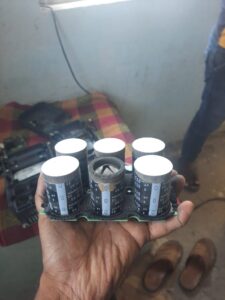Capacitor burning in a Variable Frequency Drive (VFD) can occur due to several factors, including excessive voltage stress, poor capacitor quality, electrical overloading, or improper installation. Let’s delve into a detailed explanation of why capacitor burning can happen in VFDs:
1.Excessive Voltage Stress
VFDs use capacitors in their DC bus section to smooth the rectified AC voltage and provide stable DC voltage for the inverter section. If the VFD experiences voltage spikes or surges beyond the rated voltage of the capacitors, it can cause excessive stress on the capacitors. These voltage stress events can lead to capacitor failure, including burning or explosion.
2.Poor Capacitor Quality
Capacitor quality plays a crucial role in the overall reliability and lifespan of VFDs. Inferior quality capacitors may not be able to handle the electrical and thermal stresses encountered in VFD applications. Capacitors with lower voltage ratings, inadequate current handling capabilities, or insufficient temperature tolerance are more prone to failure and burning. It is essential to use high-quality capacitors specifically designed for VFD applications to minimize the risk of burning.
3.Electrical Overloading
If the VFD is subjected to continuous overloading, it can cause excessive current flow through the capacitors. Overloading can occur due to factors such as motor overload, voltage imbalance, excessive harmonics, or a mismatch between the VFD and motor. The increased current flowing through the capacitors generates excess heat, which can eventually lead to capacitor burning.
4.Improper Installation
Incorrect installation practices can contribute to capacitor burning in VFDs. Common installation mistakes include incorrect wiring, inadequate cooling, insufficient spacing between components, and poor ventilation. Improper wiring or loose connections can result in increased resistance and heat generation, leading to capacitor failure. Insufficient cooling or ventilation can cause the capacitors to operate at elevated temperatures, which can degrade their performance and potentially result in burning.
5.Environmental Factors
The operating environment of the VFD can also impact capacitor performance and longevity. Factors such as high ambient temperatures, excessive dust or dirt accumulation, presence of corrosive substances, or high humidity levels can degrade capacitor performance and increase the risk of burning. It is crucial to consider the environmental conditions and provide suitable protective measures, such as proper enclosures, cooling, and maintenance, to mitigate these risks.
6.Voltage Transients and Surges
Voltage transients and surges in the power supply can place additional stress on the capacitors. These transient voltage events can occur due to lightning strikes, utility switching, or electrical disturbances within the system. Capacitors are designed to handle a certain range of voltage fluctuations, but if the magnitude or frequency of the transients exceeds their capabilities, it can lead to capacitor failure and burning. Implementing surge protection devices and voltage regulation measures can help mitigate the risk of capacitor damage from such events.
7.Harmonic Distortion
VFDs generate harmonics, which are multiples of the fundamental frequency, due to the switching nature of their power electronics. These harmonics can cause additional stress on the capacitors. Capacitors are not designed to handle high-frequency currents, and prolonged exposure to excessive harmonics can lead to increased heating and premature failure. Employing harmonic mitigation techniques such as line reactors, harmonic filters, or active front-end VFDs can help reduce the harmonic content and minimize the risk of capacitor burning.
8.Age and Wear
Over time, capacitors may experience degradation of their dielectric materials, increased internal resistance, or drying of the electrolyte. These age-related factors can compromise the performance and reliability of the capacitors, making them more susceptible to burning. Regular preventive maintenance and periodic replacement of capacitors can help mitigate the risks associated with aging and wear.
9.Overvoltage or Under voltage Conditions
Capacitors in VFDs are designed to operate within specific voltage ranges. Exposure to overvoltage conditions, where the voltage exceeds the rated value, or undervoltage conditions, where the voltage drops below the specified level, can cause stress on the capacitors. Overvoltage conditions can lead to overcharging of the capacitors and accelerated aging, while undervoltage conditions can result in inadequate capacitor performance and increased current draw. Ensuring proper voltage regulation and protection mechanisms can help prevent capacitor burning caused by voltage fluctuations.
10.Manufacturing Defects
In rare cases, capacitor burning can occur due to manufacturing defects or component failures. These defects can include poor internal connections, improper sealing, or material inconsistencies. While such cases are relatively rare, they can result in capacitor failure and burning. Working with reputable suppliers and manufacturers, using certified components, and conducting quality checks can help minimize the risk of using defective capacitors.
To prevent capacitor burning in VFDs, it is essential to adhere to the manufacturer’s recommendations for capacitor selection, ensure proper installation by following the manufacturer’s guidelines and industry standards, and perform regular maintenance and inspections. Monitoring voltage levels, current draw, and temperature can help detect any abnormalities and allow for timely corrective actions. Additionally, using high-quality capacitors specifically designed for VFD applications and providing adequate cooling and ventilation can significantly reduce the risk of capacitor burning and ensure reliable and safe VFD operation.
It is important to note that capacitor burning in VFDs can be a complex issue influenced by multiple factors. Addressing these factors requires a comprehensive approach, including proper system design, selection of high-quality components, adherence to installation and maintenance guidelines, and implementation of appropriate protection measures. Regular monitoring, inspection, and preventive maintenance can help identify potential capacitor issues early on and prevent catastrophic failures or burning.











